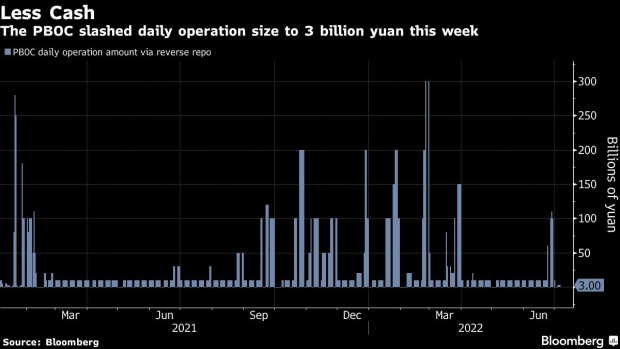Jul 6, 2022
PBOC’s Cash Drain Signals Policy Shifting From ‘Crisis Mode’
, Bloomberg News

(Bloomberg) -- China’s central bank looks set to withdraw cash from its financial system in a sign that it’s moving toward normalizing monetary policy as major global peers are forcefully raising interest rates.
The People’s Bank of China slashed its daily short-term liquidity operation to 3 billion yuan ($447 million) this week, the smallest amount since January 2021. At this pace it’s likely to remove more cash in the first five days of this month than it injected toward end-June.
The move came after data last week showed manufacturing activity expanded in May for the first time since February. The shift in PBOC’s liquidity stance has already pushed up short-end bonds yields and threatens to lift money-market rates that continue to be anchored by ample cash aimed at boosting the Covid-hit economy.
“The PBOC is shifting its monetary policy from a crisis mode to a normalization,” Ming Ming, chief economist at Citic Securities, wrote in a note. The central bank tolerated the low money market rate levels in the second quarter when Covid outbreaks disturbed economic growth, but that might be coming to an end, he wrote.
The PBOC is among the few major central banks that’s still on an easing track as China’s Covid zero policy acts as a drag on the economy. It added cash to the banking system in the first half of the year via tools including the medium-term lending facility, a reduction in the reserve requirement ratio as well as by transferring its profits to the government.
Despite the recent cash drain the overnight repo rate, a measure of interbank borrowing costs, dropped to 1.2%, the lowest since January 28, highlighting the extent of excess liquidity in the banking system.
Analysts are forecasting tighter cash in the second half of the year on further withdrawals from the PBOC and as borrowing demand from corporates rises alongside an improving economy. Zhang Jingjing, an analyst at China Merchants Securities said the PBOC may try to bring the overnight repo rate closer to its seven-day rate of 2.1%.
At the current rate of liquidity withdrawals the PBOC could drain a net 428 billion yuan ($64 billion) of cash in the first five days of July, more than the 400 billion yuan it net injected before June end.
Fading Supply
The peaking out of Chinese local government bond issuance has also reduced the urgency for the PBOC to maintain funding rates low in July, according to Chen Xi, an analyst at Pacific Securities. Regional governments sold a record 4.04 trillion yuan bonds in the first six months of the year, leaving only 330 million yuan of the quota for the remaining year, according to Bloomberg data. The central bank may guide bond market leverage lower and steer more cash to the real economy, Chen said.
The front-end of China’s sovereign bond curve is already pricing in tighter cash conditions. The yield on one-year China government bonds rose to 2.01% Tuesday, the highest since June 17, while the one-year onshore interest rate swap touched 2.23% this week, the highest since March.
Still, investor caution on the economy is reflected in the long end of the curve where yields have eased over the risk of recurring Covid outbreaks. A jump in infections across Shanghai has raised the specter of another lockdown. The government bond yield curve may flatten with back-end sovereign bonds finding more support as risks to economic recovery linger, Qin Han, analyst at Guotai Junan Securities, wrote in a note.
The PBOC last week reiterated its pledge to provide stronger support for the economy. Monetary policy may prioritize credit expansion over interest reduction in the coming months, according to economists including Xiangrong Yu at Citigroup Inc., who still expect a 25 basis points reduction in reserve requirement ratio on a discretionary basis to facilitate fiscal and semi-fiscal efforts.
©2022 Bloomberg L.P.






